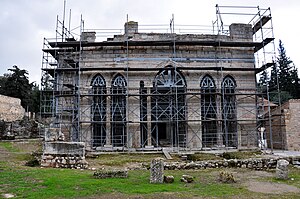Daphni Monastery
| Monasteries of Daphni, Hosios Loukas and Nea Moni of Chios | |
|---|---|
| Name as inscribed on the World Heritage List | |
 |
|
| Location | Greece |
| Type | Cultural |
| Criteria | i, iv |
| Reference | 537 |
| UNESCO region | Europe and North America |
| Inscription history | |
| Inscription | 1990 (14th Session) |
Daphni or Dafni (Modern Greek: Δαφνί; Katharevousa: Δαφνίον, Daphnion) is an eleventh-century Byzantine monastery eleven kilometers (6.8 mi) northwest of central Athens in the suburb of Chaidari, south of Athinon Avenue (GR-8A). It is situated near the forest of the same name, on the Sacred Way that led to Eleusis. The forest covers about 18 km2 (7 sq mi), and surrounds a laurel grove. "Daphni" is the modern Greek name that means "laurel grove", derived from Daphneion (Lauretum).
The Daphni Monastery was founded towards the end of the sixth century A.D. on the site of the Sanctuary of Apollo which had been desecrated by the Goths in 395. The Sanctuary of Apollo was built in the Ionic style using the thinnest and smallest columns. The columns stand on a base with an ornamental scroll at the top. A few of the columns of the temple have been preserved. One of the four Ionic columns of the ancient Sanctuary of Apollo remains at the site, as it was re-used in the Daphni Monastery. The other columns were removed and taken to London by Thomas Bruce, Earl of Elgin (of Elgin Marbles fame). The columns, column bass, and column tops from the Sanctuary of Apollo are currently in the possession of the British Museum; they are currently not on display but can be seen on the museum’s website .
The first monastery on the site was constructed in the style of a castle with a basilica in the middle. It was fortified with enclosing walls and small cells that were usually just inside the walls and used by monks or nuns. The walls were attached to the church rather than standing free around the perimeter of the property and one of the columns from Apollo was built into the southern wall of the church. Some of the rectangular blocks of porous stone were also salvaged and used in the western outer wall of the church. This first monastery fell into decline when Greece was severely damaged following invasions of barbarians from the North and the sea in the ninth and tenth Centuries A.D.
...
Wikipedia
